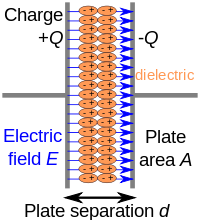
Photo from wikipedia
Abstract Sr1-xY2x/3Bi2Ta2O9 bismuth-layered compounds with composition x = 0, 0.05, 0.075 and 0.1 are synthesized by the modified conventional solid-state route. The smaller ionic radii of Y3+ in SrBi2Ta2O9 decreases the lattice… Click to show full abstract
Abstract Sr1-xY2x/3Bi2Ta2O9 bismuth-layered compounds with composition x = 0, 0.05, 0.075 and 0.1 are synthesized by the modified conventional solid-state route. The smaller ionic radii of Y3+ in SrBi2Ta2O9 decreases the lattice parameters and increases the orthorhombic distortion (b/a) confirms the lattice mismatch in the perovskite structures by X-ray diffraction. Micro - Raman spectroscopy is used to identify the various modes of metal-oxide bonds in the system. A decrease in Raman intensity and increase in full width at half-maximum of the Ta–O stretching mode at 800 cm−1 may be due to a decrease in orthorhombic distortion of the unit cells. Temperature dependence dielectric study shows the ferroelectric to paraelectric transition above 270 °C and donor substitution reduces the dielectric loss. Using a ferroelectric capacitor model, the expression for switching dipoles polarization (P) dependence of the electric field (E) is used to fit the P-E loop and gives best fit with the experimental data. The equivalent electrical circuit is modeled to identify the different components by complex impedance spectroscopy and KWW function is used to confirm the respective components by modulus spectroscopy. The water splitting photocatalysis of Sr1-xY2x/3Bi2Ta2O9 ferroelectrics for H2/O2 evolution from water in the presence of sacrificial reagents are also tested. The highest rate of H2/O2 evolution achieved for these modified ferroelectric materials under UV-light irradiation (350WHg lamp) is about 1.7 folds higher than that of pure SrBi2Ta2O9. Improved photoactivity is restructured in terms of effective charge severance of photogenerated e−/h+ pairs owing to the favourable ferroelectric polarization.
Journal Title: International Journal of Hydrogen Energy
Year Published: 2019
Link to full text (if available)
Share on Social Media: Sign Up to like & get
recommendations!